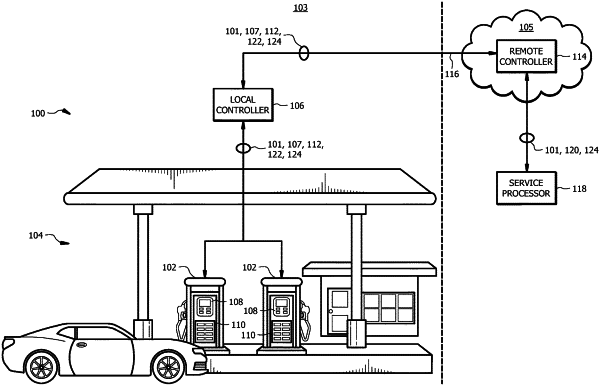| CPC G06Q 50/06 (2013.01) [G05B 19/416 (2013.01); G06Q 20/18 (2013.01); G06Q 20/385 (2013.01); G06Q 30/0237 (2013.01); G05B 2219/45076 (2013.01); G06Q 2220/00 (2013.01)] | 17 Claims |

|
1. A network-enabled fuel dispensing system, comprising:
a fuel dispenser terminal located at a first location, comprising a first processor configured to:
encrypt a service request for a fuel purchase using a public encryption key, wherein the service request comprises card information associated with a customer;
send the service request to a service processor via a remote controller, wherein:
the remote controller is located at a second location;
the service processor is located at a third location;
the second location is different from the third location; and
the remote controller and the service processor are separate devices from one another;
receive a personalized offer for the customer in response to sending the service request, wherein the personalized offer comprises a coupon for a product available at the first location;
display at least a portion of the personalized offer;
receive a user response that indicates the coupon was accepted;
send the user response to the remote controller;
receive an authorization token for retrieving the product from the first location in response to sending the user response to the remote controller; and
output the authorization token, wherein outputting the authorization token comprises wirelessly transmitting the authorization token to a user device that is associated with the customer; and
the remote controller located at the second location that is different from the first location, comprising a second processor configured to:
intercept the service request transmitted by the fuel dispenser terminal to the service processor;
determine a timestamp for when the service request is received;
decrypt the service request using a private encryption key;
identify a customer profile for the customer based on the card information associated with the customer;
access transaction history associated with the card information, wherein the transaction history comprises information about a set of products that the customer has purchased in the past using a card associated with the card information;
access inventory information associated with the first location, wherein the inventory information indicates products that are available at the first location;
identify the product that is available at the first location and that the customer has purchased before based at least in part on the customer profile, the transaction history, and the inventory information, wherein the product is a product relevant to the customer;
select the coupon associated with the identified product based at least in part upon the timestamp when the service request is received, such that the selected coupon is active at the timestamp;
send the personalized offer identifying the product available at the first location in response to receiving the service request;
receive the user response;
determine the coupon was accepted based on the user response;
update the service request in response to determining that the coupon was accepted, wherein updating the service request comprises adding a purchase of the product to the fuel purchase in the service request;
re-encrypt the service request using the same public encryption key that was used by the fuel dispenser terminal, wherein re-encrypting the service request reconstructs the service request sent by the fuel dispenser terminal;
send the re-encrypted service request to the service processor;
receive an authorization confirmation in response to sending the re-encrypted service request to the service processor;
generate the authorization token in response to receiving the authorization confirmation; and
send the authorization token to the fuel dispenser terminal.
|